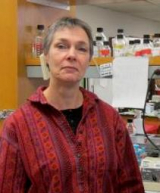Sialic Acids- An Achilles Heel for Acute Lymphoblastic Leukemia Cells

As featured in the 9/2013 ALSF E-News:
“ALSF support was very important for the continuation of our studies on ALL.” – Nora Heisterkamp, PhD
Nora Heisterkamp, PhD and her colleagues at Children's Hospital Los Angeles have been trying to understand how acute lymphoblastic leukemia (ALL) cells, become drug-resistant. The team recently found that when ALL cells become drug-resistant, they contain high levels of modified sialic acid, a sugar found on the surface of the cells. To their surprise, when the modification was removed, the ALL cells were killed. Even better - it had no effect on healthy cells.
This is an important discovery that ideally will lead to an entirely new type of drug therapy for ALL based on sialic acid modification, which is not only effective but also has less toxic side effects.
Although Dr. Heisterkamp has been studying sialic acid modification for quite some time, the project was in jeopardy when she did not receive funding from the NIH to continue the project. She applied for an ALSF Bridge Grant and was awarded funding to keep the project on track, while she reapplied to the NIH.
In addition to the promising results of the research, Dr. Heisterkamp recently found out that she was awarded NIH funding for the project again.
This is a perfect example of why ALSF developed Bridge Grants and exactly how they're intended to be used - as a "bridge" of sorts to make sure important research projects are not compromised despite decreased funding available from the federal government.
Project Goal
All cells, including pediatric and adult acute lymphoblastic leukemia (ALL) cells, are covered by a dense, complex layer of sugars. Scientists studying ways to kill leukemia cells currently focus on the genes (DNA) and the direct products of DNA (RNA and proteins) as potential targets for diagnosis or treatment. The sugar layer is difficult to analyze and because of this has received very little attention. The study of carbohydrate modifications --glycosylation- is regarded by many as the last frontier in biology. We became interested in glycosylation when our experiments indicated that ALL cells have different sugars on their surface when they develop resistance to drugs. We focused on the modification of a sugar called sialic acid because others had shown that its further chemical modification can be used to monitor relapse in childhood ALL. We found that this chemical modification not only is diagnostic for ALL but that, unexpectedly, its removal with an enzyme caused the cells to die. The same treatment had no effect on non-ALL cells. Mice that had been transplanted with human ALL cells carrying the enzyme were cured of leukemia when the enzyme was activated from inside the leukemia cells. Our experiments will determine how this causes ALL cells to die, if the modification causes drug resistance of ALL cells, and which life-or-death determining critical molecule(s) carry this modification in ALL cells. The data we generate will allow us to develop an entirely new type of drug therapy for ALL based on sialic acid modification.
Project Update:
Glycosylation could be regarded as the final frontier in biology. Our lab studies the development of drug resistance in acute lymphoblastic leukemia. Scientists have examined drug-resistant ALL cells for changes in their DNA (genome), in RNA expression and the proteins (proteome) that are made by coding RNA. How to analyze changes in carbohydrates that are attached to biomolecules including proteins and lipids, is much more problematic because these changes are not “template-driven” such as is the case for RNA and protein. Yet over 1% of our DNA is used to encode the enzymes and other proteins that synthesize and modify our ”glycome.”
Something that is difficult to analyze is not necessarily unimportant. In fact, carbohydrates on the surface of cells play tremendously important roles in immunology, and ALL is a cancer of immune cell precursors. Thus, our quest to find new targets for treatment of drug-resistant ALL led us to explore the glycome of such cells.
Carbohydrates that decorate the outside of all cells can be compared to trees, with the trunk and branches consisting of combinations of glucose, mannose, fucose or other carbohydrate monomer building blocks. Sialic acids are acidic carbohydrates that are often added to the final branches of such trees (“the leaves”). They can be further chemically modified by addition of an acetyl group to the carbon backbone. Sialic acids have significant biological effects because they stick out and form the ultimate part of the tree.
What were you initially studying with your grant funded by ALSF?
Our lab has been studying how leukemia cells develop insensitivity to drug treatment when the leukemia cells are supported by non-cancer cells such as those found in the bone marrow. We are trying to unravel how this bystander support works.
What have you found?
We used a carbohydrate-binding protein (called CCA-lectin) that has an exquisite specificity for only detecting sialic acids that are acetylated on carbon 9 as a detection tool to analyze human patient-derived ALL cells as they became insensitive to drug therapy, using fluorescent-activated cell sorting. We also made use of an esterase that is produced by influenza virus C and that clips this acetyl group off sialic acids.
The results from our studies were extremely interesting and provoking. We found that this modification is increased on biomolecules (proteins and the ganglioside GD3) on the surface of human and mouse ALL cells as they develop resistance to different drugs, indicating this is a general modification. The most spectacular result obtained was when we removed the 9-O-acetyl group using a variety of different approaches: the ALL cells in which the modification was removed died. We transplanted mice with human ALL cells that had been engineered to contain the esterase gene in an inducible fashion. We allowed the leukemia cells to proliferate, then switched on the esterase production in the ALL cells. Remarkably, we found we had virtually eradicated the ALL cells, even in the bone marrow of mice. This provides a proof-of-principle that the 9-O-acetylation of sialic acids not only marks the emergence of drug-insensitive ALL cells, but also is key to the continued survival of the cells.
What does this mean for children with cancer and their families?
We hope that our discoveries will lead to the development of therapeutics in the future that are different than those currently in use and will provide an alternative treatment for patients. For example, an antibody that reacts with 9-O-acetylated sialic acids could be used in cell-based therapies.
What are the next steps?
We are currently trying to understand how this particular modification is generated by the ALL cells, why it is so important for the survival of these leukemia cells, and are thinking of ways to use this knowledge to eradicate them.
Has this research been published?
We published some of our findings this year in the Journal of Experimental Medicine.
What has this grant from ALSF allowed you to do that you wouldn’t be able to do otherwise?
The proposal for which we obtained ALSF Bridge funding was a National Institutes of Health fall 2012 resubmission of a competitive renewal that had been supported by the National Cancer Institute for 11 years until 6/1/2012. The ALSF funding was critical, as it allowed us to continue our studies and perform experiments that otherwise would have had to be terminated because of lack of funding.
Why did you choose to work in this field/on this topic?
We have been investigating the molecular causes of leukemia for over 30 years. Because the development of drug resistance is one of the major possible problems facing patients with this type of cancer, we are focusing our efforts on understanding mechanisms by which it develops. There are many different ways to approach this problem but we have chosen to follow a path that is less well traveled.

